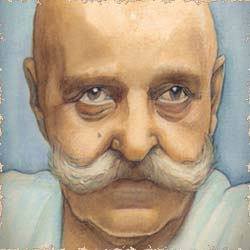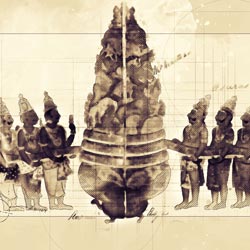

The Buddha
The knowledge of Buddhism is naturally associated with the Buddha’s discourses and those of his disciples. Buddha’s sayings were compiled by his followers and arranged into themes. Although the philosophy of Buddhism ultimately tackles the most profound aspects of human existence – attachment, suffering, death, karma, and consequent rebirth – the Buddha’s sayings are often remarkably down to earth and accessible. “One is not wise because he talks a good deal;” he is quoted to have said in the Dhammapada; “They are wise who are patient, and free from hate and fear.” In this approachable spirit, Buddha’s sayings span subjects such as anger, greed, fear, and happiness, inviting anyone to follow his path, at the price of studying and affirming his concise and accessible aphorisms.
Alongside this literal or exoteric teaching, however, there existed an esoteric Buddhism. While the exoteric spoke literally, the esoteric instructed metaphorically. It raised a mirror before practitioners, inviting them to learn by examining themselves. This esoteric Buddhism placed the initiative on the shoulders of the practitioner. He or she had to take a step towards truth. Then the teaching would either confirm or challenge their observations. The premise behind this method is that truth cannot be expressed literally without being corrupted, but it can be experienced. Therefore, truth should be taught, not through explicit instruction, but through reflection. “Pure knowledge cannot be transmitted,” said George Gurdjieff, “but by being expressed in symbols it is covered by them as by a veil, although at the same time for those who desire and who know how to look this veil becomes transparent.”i

The Buddha

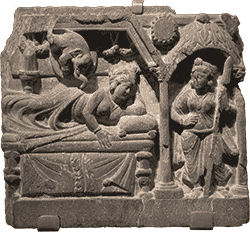
Conception of Prince Siddhartha
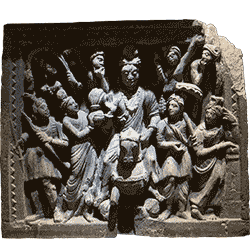
Siddhartha’s Departure from the Palace
Esoteric Buddhism in Early Temples
As the Buddha himself was the obvious example of a being who had traversed the path to truth, esoteric Buddhism reflected the nature of this journey through the story of the Buddha’s life. Each phase of his development represented the path and pitfalls to self-realization. Accordingly, episodes from the life of the Buddha lined the walls of early Buddhist temples. Scenes of his mother’s auspicious conception, the birth, the first seven steps, the gradual realization of being imprisoned — all the way to enlightenment under the Bodhi tree, decorated the temple walls. Exoterically, the decorative scheme was acquainting the worshiper with the story of the life of the founder of Buddhism. Esoterically, however, through reflection, the practitioner was learning the steps that lead from imprisonment to liberation.

Conception of Prince Siddhartha

Siddhartha’s Departure from the Palace
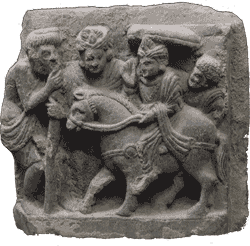
Siddhartha Encountering Old Age
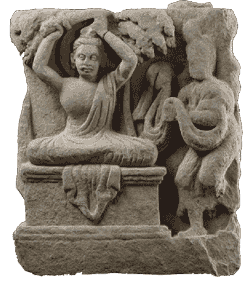
Siddhartha Renouncing the World

Siddhartha Encountering Old Age

Siddhartha Renouncing the World


Esoteric Buddhism on Conception and Birth
Esoteric Buddhism retells the allegorical story of its founder from its very beginning, from the moment of Buddha’s conception. (Indeed, later developments of esoteric Buddhism would reach even farther back time, beyond time, tracing the Buddha’s former lives that steadily progressed in merit till his incarnation as Prince Siddhartha.) From his very conception, the life of Prince Siddhartha bears the auspicious hallmarks of exceptional potential. The narrative implies that escape from the cycle of endless birth and death is irrevocably engraved onto his destiny. The ending of the story is predetermined; it is only a matter of how this destiny comes to fulfillment.
Since the mother of the Buddha-to-be naturally plays a central role in his conception, his life story begins with her. Queen Maya is described as ‘pure, chaste, loyal to her husband, and generous to her subjects.’ ‘Maya’ is Sanskrit for ‘deceit,’ and the queen earns this title for being free of all deceit. The Buddhacarita compares her to, “… the splendor of the sun when it is free from all the influence of darkness.” This immaculate nature of the mother will prove crucial for launching the Buddha’s earthly life in its destined direction.
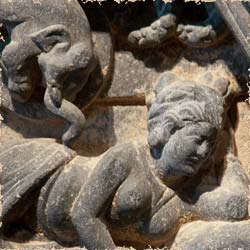
Conception of Prince Siddhartha | Detail of Elephant

The Esoteric Interpretation of Buddha’s Conception and Birth
Queen Maya conceives Siddhartha at night—understandably, for intercourse between husband and wife typically occurs in bed at nighttime—although Maya’s conception is anything but typical. In a dream, she is transported to the Himalayas, where a six-tusked white elephant touches her right side. An early Buddhist relief illustrates this ‘immaculate conception’, displaying the queen reclined, the haloed elephant descending towards her, and its tusk tapping her right side. In early renditions of this scene, despite it being nighttime, a sunny orb shines over Maya’s pavilion. The contrast between apparent darkness and imminent light will underlie this fateful moment, as well as the rest of Siddhartha’s destiny.

Conception of Prince Siddhartha | Detail of Elephant
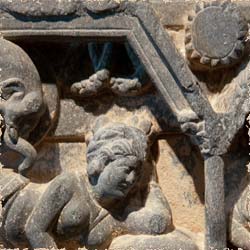
Conception of Prince Siddhartha | Detail of Sun

Conception of Prince Siddhartha | Detail of Sun
The description in the Buddhacarita of Buddha’s immaculate conception hints to its esoteric meaning: “Then, falling from the host of beings in heaven… the most excellent of the Bodhisattvas suddenly entered at a thought into [the queen’s] womb.” The meeting of male and female principles is presented as something mental and internal, suggestive of a metaphysical conception. If the male seed is, in fact, a ‘thought’, then the queen’s receptive womb is acting as an echo chamber that receives and amplifies this thought.
Our psychology perpetually harbors thoughts that stimulate emotions. We think of the long day ahead and feel dread. We recall a compliment received last night and feel satisfaction. The internal coupling of thoughts with emotions is ongoing. Herein lies the importance of Queen Maya’s purity and chastity. The heart indiscriminately amplifies our random thoughts just as an echo chamber indiscriminately amplifies anything it harbors. To use the mechanism of the heart properly, we must learn to bar useless thoughts from entering it. The Dhammapada confirms this esoteric interpretation: “Those who control the mind which wanders afar [source of associative thoughts]… and which resides in the inner cavern of the heart [amplifying mechanism], will liberate themselves from the shackles of Mara.”
“When a man who has his real I… pronounces to himself the words “I am,” explains George Gurdjieff, “then there always proceeds in him, in his “solar plexus,” a “reverberation,” something like a vibration or a feeling.”ii In describing the Buddha-to-be’s conception, esoteric Buddhism outlines the fundamental principle of prayer. A potent thought or mantra can potentially trigger profound emotion. In this way, recitation of thoughts can alter our emotional state, provided we first purify our hearts from associative thinking.


Esoteric Buddhism on Our Psychological Prison
To Queen Maya, the significance of the dream is, at first, unclear. She shares her vision with her husband, King Suddhodana, who recognizes its auspicious nature and summons his advisers to interpret it. “Be not anxious, sire,” the Brahmins reassure their master,” Your queen has conceived: and the fruit of her womb will be a son… If he adopts a householder’s life, he will become a universal monarch; but if, leaving his home, he adopt the religious life, he will become a Buddha.”

Maya and Suddhodana Consulting Brahmin
The sages’ interpretation proves true; Maya grows pregnant till, nine months later, she delivers a very special son who, “Having thus issued from the womb, shone as if he had come down from heaven.” The temple reliefs show her holding on to a palm tree while her ladies in waiting help her deliver Siddhartha from her right side, the same side on which she was tapped nine months earlier in her dream.
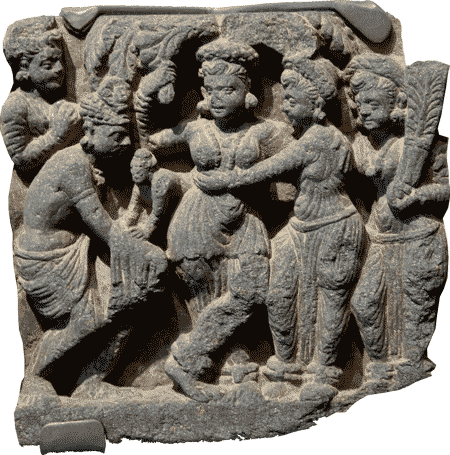
Queen Maya Giving Birth

Queen Maya Giving Birth
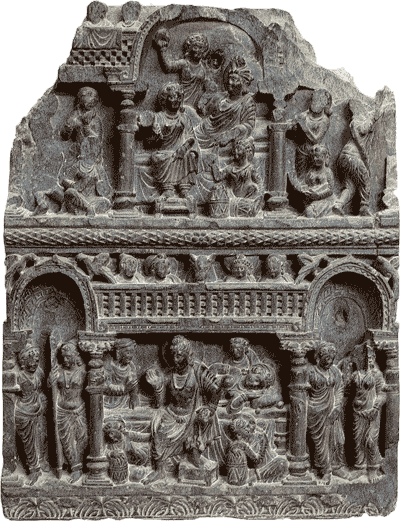
Prince Siddhartha in his Palace
Now that the sages’ interpretation of Maya’s dream has proven correct, King Suddhodana considers how to handle their accompanying prophecy. His son would either become a great monarch or an enlightened Buddha. Eager to avert the latter and and affect the former, Suddhodana schemes to confine his son to a palace barred from the outside world and its cares. He will order his ministers not to expose the boy to tragedy, or allow him to lack anything he desires. By shielding Siddhartha from troublesome impressions, Suddhodana hopes to prevent his son from questioning the material life.

Prince Siddhartha in his Palace

As it stands, Siddhartha will grow up taking the luxury and learning of his palace to be the norm. He will perceive the absence of suffering to be the rule. He will form a distorted image of the world, one very different from reality. In portraying its founder in this way, Esoteric Buddhism outlines the condition of all human beings. We spend our lives barred from the objective world around us. Our subjectivity is formed by a combination of factors not in our own hands. One big influence in its formation is our upbringing and conditioning. Hence the role of Siddhartha’s father in this construct. Despite the Esoteric Buddhist allegorical story, however, this condition applies to princes and paupers alike, to those raised in palaces or poverty: we do not see the world as it is; we see it as we are.
Alongside this fundamental point, Esoteric Buddhism stresses another element: we are ignorant of our own subjectivity. Siddhartha is imprisoned in his palace unawares. Needless to say, as long as he dwells in this bubble unsuspectingly, he will never make any effort to escape it. “Gurdjieff often returned… to this example of “prison” and “escape from prison” in his talks,” said Peter Ouspensky. “Sometimes he began with it, and then his favorite statement was that, if a man in prison was at any time to have a chance of escape, then he must first of all realize that he is in prison.”i
[To be continued…]


Sources
- In Search of the Miraculous by Peter Deminaovich Ouspensky
- Life is Only Real Then, When ‘I Am’ by George Gurdjieff

In 2022/24, BePeriod will be creating a full-length documentary on George Gurdjieff
Subscribe to our mailing list
Subscribe to our mailing list
Continue Reading:
© BePeriod

